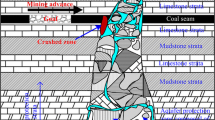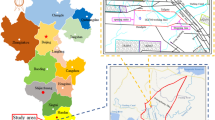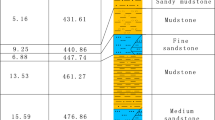Abstract
A karst collapse pillar (KCP) is caused by the karst subsidence that occurs in carbonate rock distribution areas. Current KCP studies focus mainly on aspects such as the cause of formation, rule of development, groundwater inrush, and structural characteristics of the pillar and sidewall rock body. However, few existing studies focus on the influences of mining activity on the damage to KCP, its surrounding rocks, and the formation of the fracture zone, especially the mechanical behavior. In this paper, a numerical fast Lagrangian analysis of continua in three dimensions model was created to understand the mechanical state of a coal seam penetrated by a KCP during mining panel extraction. The numerical results suggest that (1) because of the structure defect, the stress field strongly depends on the mining activity, and the stress distribution varies in different parts of the KCP; (2) KCP and the surrounding rocks show dislocation when the working face passes the KCP, at which point shear failure may then occur, which will lead to a sidewall channel for groundwater inrush; and (3) as mining advances, the plastic zone in the KCP and its broken area develop gradually until the upper and lower plastic zones connect when the working face passes the KCP, which will cause a channel for groundwater inrush.












Similar content being viewed by others
References
Bai HB, Ma D, Chen ZQ (2013) Mechanical behavior of groundwater seepage in Karst collapse pillars. Eng Geol 164:101–106
Cheng YM, Wang JA, Xie GX, Wei WB (2010) Three-dimensional analysis of coal barrier pillars in tailgate area adjacent to the fully mechanized top caving mining face. Int J Rock Mech Min Sci 47:1372–1383
Fama MED, Trueman R, Craig MS (1995) Two- and three dimensional elasto-plastic analysis for coal pillar design and its application to high wall mining. Int J Rock Mech Min Sci Abstr 32:215–225
Gutiérrez F, Guerrero J, Lucha P (2008) A genetic classification of sinkholes illustrated from evaporite paleokarst exposures in Spain. Environ Geol 53(5):993–1006
He KQ, Guo D, Du W, Wang R (2007) The effects of karst collapse on the environments in North China. Environ Geol 52(3):449–455
He KQ, Yu GM, Lu YR (2009) Palaeo-karst collapse pillars in northern China and their damage to the geological environments. Environ Geol 58(5):1029–1040
He K, Zhang S, Wang F (2010) The karst collapses induced by environmental changes of the groundwater and their distribution rules in China. Environ Earth Sci 10:1075–1084
Hoek E (1990) Estimating Mohr-Coulomb friction and cohesion values from the Hoek-Brown failure criterion. Int J Rock Mech Min Sci Abstr 27:227–229
Hoek E, Carranza-Torres C, Corkum B (2002) Hoek-Brown failure criterion-2002 edition. In: Proceedings of the Fifth North American Rock Mechanics Symposium, Toronto, Canada, vol 1. pp 267–273
Hoek E, Marinos P, Benissi M (1998) Applicability of the geological strength index (GSI) classification for very poor and sheared rock masses. The case of the Athens schist formation. Bull Eng Geol Environ 57:151–160
Itasca Consulting Group Inc., (2006) FLAC3D (Fast Lagrangian Analysis of Continua in 3 Dimensions), version 3.1. Minneapolis, Minnesota, United States
Jiang YD, Wang HW, Xue S, Zhao YX, Zhu J, Pang XF (2012) Assessment and mitigation of coal bump risk during extraction of an island longwall panel. Int J Coal Geol 95(1):20–33
Kang Y (1992) A discussion of karst collapse formulation patterns. Hydrogeol Eng Geol 19(4):32–33 (in Chinese and abstract in English)
Li GY, Zhou WF (2006) Impact of karst water on coal mining in North China. Environ Geol 49:449–457
Lokhande RD, Murthy VMSR, Singh KB (2013) Pot-hole subsidence in underground coal mining: some Indian experiences. Geotech Geol Eng 31(2):793–799
Ma D, Miao XX, Chen ZQ, Mao XB (2013) Experimental investigation of seepage properties of fractured rocks under different confining pressures. Rock Mech Rock Eng 46:1135–1144
Ma D, Miao XX, Jiang GH, Bai HB, Chen ZQ (2014) An experimental investigation of permeability measurement of water flow in crushed rocks. Transp Porous Media (in press). doi:10.1007/s11242-014-0385-5
Miao XX, Cui XM, Wang JA, Xu JL (2011a) The height of fractured water-conducting zone in undermined rock strata. Eng Geol 120:32–39
Miao XX, Li SC, Chen ZQ, Liu WQ (2011b) Experimental study of seepage properties of broken sandstone under different porosities. Transp Porous Media 86:805–814
Pietruszczak S, Mro Z (1980) Numerical analysis of elastic-plastic compression of pillars accounting for material hardening and softening. Int J Rock Mech Min Sci Abstr 17:199–207
Qian X (1988) The formation of gypsum karst collapse pillars and hydrogeologic implications. Carsologica Sin 4:344–346. (in Chinese and abstract in English)
Shi J, Lian D, Yang S (1998) A discussion of karst collapse. Geol Min Res North China Mag 13(3):264–266 (in Chinese and abstract in English)
Singh R, Sheorey PR, Singh DP (2002) Stability of the parting between coal pillar workings in level contiguous seams. Int J Rock Mech Min Sci 39(1):9–39
Tharp TM (1999) Mechanics of upward propagation of cover–collapse sinkholes. Eng Geol 52(1):23–33
Troitzky GM (1993) Sinkhole danger–engineering problem of covered karst, applied karst geology. Balkema, Rotterdam, pp 231–232
Wang HW, Jiang YD, Zhao YX, Zhu J, Liu S (2013) Numerical investigation of the dynamic mechanical state of a coal pillar during longwall mining panel extraction. Rock Mech Rock Eng 46(5):1211–1221
Wu Q, Xu H, Pang W (2008a) Advances and challenges of GIS and DBMS applications in karst. Environ Geol 54(5):937–943
Wu Q, Xu H, Pang W (2008b) GIS and ANN coupling model: an innovative approach to evaluate vulnerability of karst water inrush in coalmines of north China. Environ Geol 54:937–943
Wu Q, Xing LT, Ye CH, Liu YZ (2011) The influences of coal mining on the large karst springs in North China. Environ Earth Sci 64:1513–1523
Xeidakis GS, Torok A, Skias S, Kleb B (2004) Engineering geological problems associated with karst terrains: their investigation, monitoring, and mitigation and design of engineering structures on karst terrains. Bull Geol Soc Greece 36:1932–1941
Xiang Y (1993) The mechanics model on flooding process of collapse pillar. Coal Geol Explor 21(5):36–39 (in Chinese and abstract in English)
Yang W, Zhou Z, Li Z (2001) Analysis of the filling characteristics of karstic collapse pillars and its reactivation-inducted water conducting. Carsologica Sin 4:279–283 (in Chinese and abstract in English)
Yao BH, Wei JP, Wang DK, Ma D, Chen ZQ (2013) Numerical study of seepage property of karst collapse columns under particle migration. CMES—Comput Model Eng Sci 91(2):81–100
Yin SX, Zhang JC (2005) Impacts of karst paleo-sinkholes on mining and environment in northern China. Environ Geol 48:1077–1083
Yuan D (1994) Karstology of China. Geological Publishing House, Beijing (in Chinese)
Zhang JC (2005) Investigations of water inrushes from aquifers under coal seams. Int J Rock Mech Min Sci 42:350–360
Zhang JC, Peng SP (2005) Water inrush and environmental impact of shallow seam mining. Environ Geol 48:1068–1076
Zhang Y, Qu Y, Liu G, Lu P (2000) Some problems of karstic collapse pillars in North-China-type coalfields. J Eng Geol 1:35–39. (in Chinese and abstract in English)
Zuo JP, Peng SP, Li YJ, Chen ZH, Xie HP (2009) Investigation of karst collapse based on 3-D seismic technique and DDA method at Xieqiao coal mine China. Int J Coal Geol 78(4):276–287
Acknowledgments
This work was supported by the National Basic Research Program of China (2013CB227900), the National Natural Science Foundation of China (U1261201), the Innovative Research Group of the National Natural Science Foundation of China (51421003), the National High Technology Joint Research Program of China (2012BAB13B00), the 111 Project of China (B07028), and the Basic Research Program of Jiangsu Province (BK20130051).
Author information
Authors and Affiliations
Corresponding author
Rights and permissions
About this article
Cite this article
Ma, D., Bai, H. & Wang, Y. Mechanical behavior of a coal seam penetrated by a karst collapse pillar: mining-induced groundwater inrush risk. Nat Hazards 75, 2137–2151 (2015). https://doi.org/10.1007/s11069-014-1416-9
Received:
Accepted:
Published:
Issue Date:
DOI: https://doi.org/10.1007/s11069-014-1416-9




